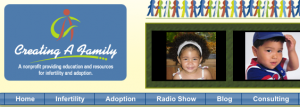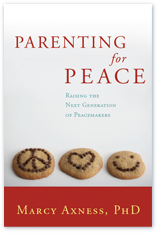I’m being hosted on five fabulous parenting sites for a discussion of “The Mommy Mind Meld: Turbo-Charge Your Baby’s Brain Development.” This new, very short YouTube video makes for a good prologue to the tour, which begins in just a few hours (whee!!):
Starting Monday (4/23) they’ll each put up my guest post, and for the rest of the week I will be on hand to field questions, comments, love mail, less-than-love mail, the whole gamut. Here are the blog stops: pick one or more to suit your fancy, and please do stop in!!
Join me on this Blog Tour April 23 – 27
I’d Love to Have All Your Voices Chime In!
The Mommy Mind Meld
One of the most powerful ways in which this parent-as-model process shapes your child’s optimal wellbeing is in the realm of actual brain development: the relatively new field of attachment neurobiology has revealed that our babies and children actually *piggyback* on the self-regulation capacities of the limbic systems in our own brain! When you hold a distressed infant in your arms, the soothing she experiences doesn’t just come from your secure embrace, but also from the actual regulation and modulation of her aroused nervous system that happens when her immature social-emotional brain actually *links up with* your more mature one!
While the researchers use such terms as “biological synchronicity”[i] and “limbic resonance,”[ii] the sci-fi image of “mind-melding” captures it well. Writes one researcher, in evident awe, “It is a biologically based communication system that involves individual organisms directly with one another: the individuals in spontaneous communication constitute *literally a biological unit*.”[iii]
But it gets even wilder than that, and has more far-reaching implications for your child’s lifelong wellbeing and success… {and drop by one or more of the above blogs to find out more!}
Marcy Axness, PhD, is the author of Parenting for Peace: Raising the Next Generation of Peacemakers.
[i] Schore, A. N. “Attachment and the Regulation of the Right Brain.” Attachment and Human Development 2, no. 1 (2000): 23-47.
[ii] Lewis, Thomas et al. A General Theory of Love. New York: Random House, 2000.
[iii] Buck, R. “The Neuropsychology of Communication: Spontaneous and Symbolic Aspects.” Journal of Pragmatics 22 (1994): 265-78, quoted in Schore, Allan N. “The Neurobiology of Attachment and Early Personality Organization.” Journal of Prenatal and Perinatal Psychology and Health 16, no. 3 (2002): 249-63; italics added for emphasis.
Tags: brain development, epigenetics, fetal brain development, interpersonal neurobiology, social intelligence








While other authors have focesud their attention on the brain of the developing child (What’s Going on in There by Lise Eliot, Ph.D. and The Scientist in the Crib by Alison Gopnik, PhD, Andrew N. Meltzoff, Ph.D., and Patricia K. Kuhl, Ph.D.), in their book Parenting from the Inside Out: How a Deeper Self-Understanding Can Help you Raise Children Who Thrive, Siegel and Hartzell zero in on what’s going on inside the parent’s brain specifically how new research in the areas of neurobiology and attachment theory can help parents to understand why they parent the way they do and what they can do to use that knowledge to become better parents. The authors stress the importance of making peace with your past so that you can avoid repeating any negative patterns of family interaction with your own kids: In the absence of reflection, history often repeats itself and parents are vulnerable to passing on to their children unhealthy patterns from the past. Understanding our lives can free us from the otherwise predictable situation in which we recreate the damage to our children that was done to us in our own childhoods .By making sense of our lives we can deepen a capacity for self-understanding and bring coherence to our emotional experience, our views of the world, and our interactions with our children. The book’s content is excellent, but it’s pretty heavy-going at times. The authors offer the reader a mix of straight narrative, introspective journaling exercises, and lessons in neurobiology. It’s all fascinating stuff, but it requires a lot of focus and attention. Definitely not to be attempted with a child in the room!
Well said, Sebastian — that’s why I cite and refer to Parenting from the Inside Out so much in my own book!
Congratulations Marcy, it seems your work is taking off, and I look forward to reading more!
it is time for us to treat our babies better…please watch my film babyhood, which is also about this…peace and love x
It’s impossible to say soitmheng can change your life without slipping into cliche-land, but this book is all about the possibility of change and the crux of life: brain, to mind, to heart, and though the book is too grounded in science to say it, to soul; it’s the neurology behind the fact that mind is love; but more than anything the ideas in this book are simply fascinating and useful! I have read other work by Dan Siegel and each time I revisit his sythesis of brain science, attachment theory and a warm-hearted psychiatrist’s view of Buber’s I-Thou, I am filled with new thoughts and emotions.